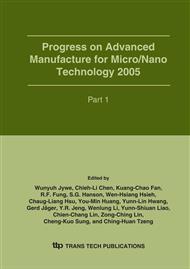p.385
p.391
p.397
p.403
p.409
p.415
p.421
p.427
p.433
Experimental Investigation of High-Resolution Injection Technique in Microfluidic Chips
Abstract:
This paper presents an experimental investigation on the use of high-resolution injection techniques to deliver sample plugs within electrophoresis microchips. Two novel injection microfluidic chips are proposed, which employ conventional cross-shaped and U-shaped injection system combined with an expander to deliver high-quality sample plugs for detection in separation channel. The valving characteristics on microfluidic devices are controlled through appropriate manipulations of the electric potential strengths during the sample injection and separation steps. These novel injection techniques developed in this study has an exciting potential for use in high-quality, high-throughput chemical analysis applications and in many other applications throughout the field of micro-total-analysis systems.
Info:
Periodical:
Pages:
409-414
Citation:
Online since:
January 2006
Authors:
Price:
Сopyright:
© 2006 Trans Tech Publications Ltd. All Rights Reserved
Share:
Citation:


